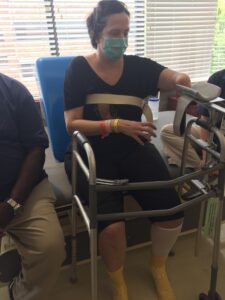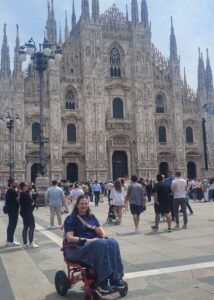Disability is complicated. I was born missing my left arm just below the elbow, but I grew up learning to do most things one-handed. Sure, there were sports I couldn’t play, instruments I couldn’t learn, and life tasks that I could never master (hammer a nail, braid my hair, knit…), but for the most part I managed to make do. I figured out ways to ride a bike, paint my nails, learn to swim, slice my own steak, put on a bra, and even learn silversmithing. I knew I was different, but got used to the odd stares, the prying questions, and the occasional fearful scream from children unprepared to encounter difference.

Apparently, I was born with another disability that took longer to fully manifest. I have a genetic disorder called Marfan’s Syndrome – a connective tissue disorder often characterized by abnormally long limbs and hyper-flexibility. I was screened for it when I was a child, but since there was no genetic testing in the early 1980s, the results were inconclusive. Nevertheless, it was present in my life, most notably causing severe scoliosis and painful Tarlov cysts at the base of my spine. I had my first back surgery in 1994, fusing my spine with rods and screws to prevent its rapidly worsening curve from crushing my internal organs. Then in 2015 I had another surgery to correct the scoliosis in the unfused parts and repair the slipped discs that the stress of the rods and earlier fusion had caused. But that surgery never fully healed – I developed a fracture in a vertebra that caused one of the screws to become loose. Over the next 6 years, that screw ate away at my spine causing severe pain and essentially severing one of my vertebrae.

So, I went back in for surgery to in Sept. 2021 to essentially refuse a vertebra that was possibly one hard sneeze away from causing complete paralysis. I woke up from that surgery unable to move my left leg. I then developed a series of blood clots down that left leg. My leg was both numb and intensely painful at the same time. I spent nearly a month in the hospital and then was sent home in a wheelchair. I could “walk” very short distances with a walker but had no ability to lift my left leg. Doctors said it would heal in time and sent me in for intensive physical therapy. While I appreciated the help the physical therapists gave, their purpose with all patients is to return them to “normal” and to get rid of mobility aids. And I did start to improve. I regained some feeling in my lower left leg over the first few months, and then in my inner thigh over the next 6 months, but then it plateaued. I kept being told to just work harder, push myself harder and then I’d heal. So, I pushed myself to the point of severe pain, to the point where I would do an exercise or activity then take days to recover often where I couldn’t do anything at all. Pushing myself caused me to feel dizzy and nauseous, my heart to race, pain to skyrocket, and visual migraines to develop.
So, I dropped out of life. I stopped going places, I stopped doing things I enjoyed. My life became very small. I could walk, but only for very short distances. Standing for more than 10 minutes would leave me in severe pain and feeling like I was about to pass out. I tried to rely on just using a cane and felt guilty about that since the physical therapists had told me the goal was to stop using even that. And using a cane with just one arm means I can’t carry anything or do anything that requires a hand while walking. I only went to places which I knew involved only a short walk and that there was ample seating. I stopped living my life, slipped into depression, and didn’t see a way out.
I was forced to admit that this was my new normal. And eventually my doctors started admitting it as well. I went through all sorts of testing. I was diagnosed with Postural Orthostatic Tachycardia Syndrome (POTS), possibly caused by the blood clots damaging my circulatory system. Neurologists found permanent nerve damage in my left leg that explained why a quarter of my leg still feels numb and the muscles do not work very well. I had to come to terms with the fact that I had mobility disabilities and no amount of pushing myself past the breaking point would ever cause that to change. It was daunting to acknowledge, but also incredibly freeing. This is who I am now and so I need to figure out ways to live my life in light of that. I wanted to be done with having to limit myself. I wanted to be with people again, travel, attend events.
So I started researching what I needed to be able to be out in the world. After my surgery my insurance covered a very basic walker and the standard medical manual wheelchair. I hated them both. The walker was way too short for my 6 feet of height and even though there was an extension for my short arm, it made for a very unbalanced experience. The wheelchair similarly wasn’t very helpful; it was overly clunky and pushing a manual wheelchair with just one arm just sent me in circles. So, if I ever wanted to use it, I had to rely on having someone to push me. I learned real quick that there was no one in my life that was willing to be that dedicated and attentive for more than just very short spans of time. It gave me no freedom. Eventually I settled on a Comodita Tipo Rollator walker – one of the few that had a seat for resting, had good off-roading wheels, and was built with the ability to accommodate tall people. I also decided to get a Fold & Go power wheelchair – again for its portability and off-roading ability. Frustratingly insurance would not cover either of these because they had already covered “perfectly functional” base level options. But the ability to start living again had to be worth the cost.

So now I am at the point of trying to accept my disability and that to live the life I want I need to rely on mobility aids. Granted, I can walk from room to room in my house and from my car into my house, with just a cane I can go to restaurants, but navigating longer distances like shopping centers, or the Ren Faire, or going anywhere downtown requires my wheelchair or walker or else I will be in extreme pain and too weak to do anything. Navigating what I need when is a learning curve that I am still getting used to. Besides getting over my own internalized ablism at being an ambulatory wheelchair user and not feeling disabled enough (whatever that means), I now face the challenge of a world that is not very accommodating to the disabled. So I want to write about my adventures here. In part committing myself to write about exploring the world with a disability will force me to actually get out of my house and start doing stuff for the first time in a few years. I also want to share with others the information I find about the accessibility of places. I’ve learned that I must pay the disability tax in time by doing the emotional labor of researching places in depth before attempting to go there, and the more reports I can make about places the less work others will have to put in doing that research.
I am choosing to be oriented to the moment – to live fully in the present. I want to savor the beauty and energy of the world as I am right now. To not fixate on a past I have lost or be deluded that if I just work hard enough, I’ll get better in the future, but instead practice turning aside to the wonder of the present moment and treasuring it.
